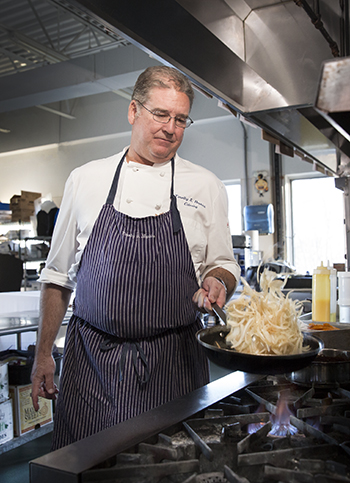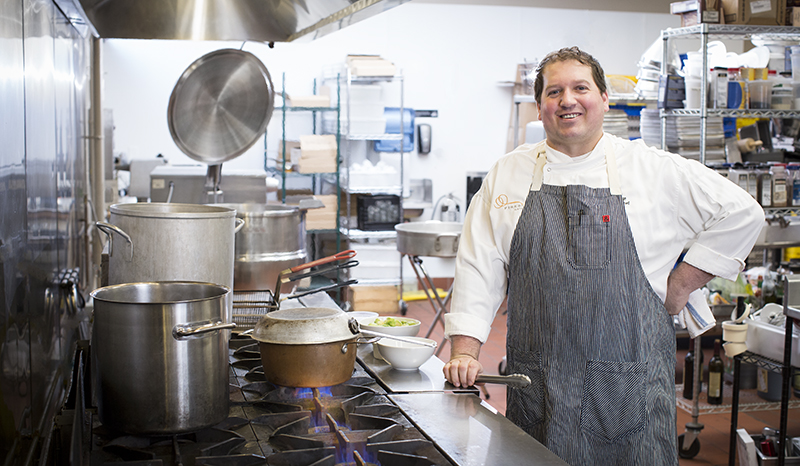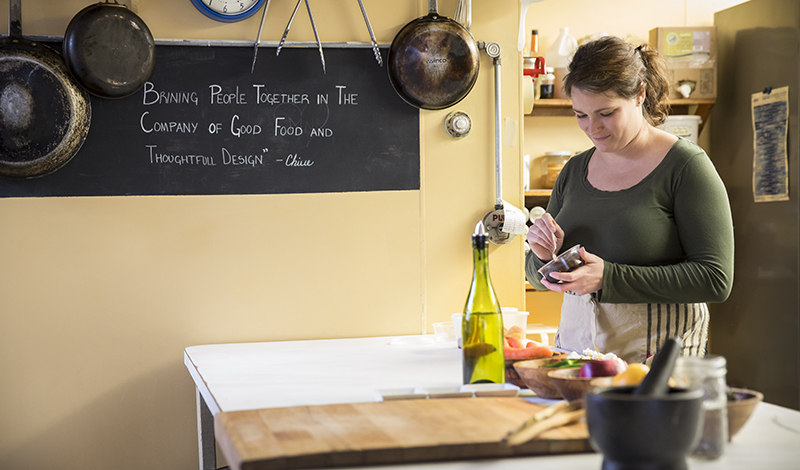For 15 years, Timothy Hopkins has built his reputation as an award-winning caterer. From his state-of-the-art 5,000-square-foot Essex kitchen, he sallies forth with signature offerings like chicken satay with spicy peanut sauce; pear, goat cheese, and fig jam; and maple-glazed scallops wrapped in bacon. This year, Hopkins sees “superfoods” on the menu. He has been working with edible seaweeds including wakame and kombu, as well as ancient grains like amaranth, farro, spelt, wheat berries, freekeh, and red quinoa. Recently, he concocted individually roasted peppers stuffed with quinoa wild mushroom risotto and farro. “They didn’t even look at the chicken,” he says of the guests in attendance. “Everyone was looking for another one of those [peppers].”
Cured, aged, brewed, and heirloom are some of the hot buzzwords these days, according to Hopkins. “Right now we are into braised, smoked, dried, and cured meats, and artisanal house-made pickles, chow-chow giardinieras, and relishes,” he says. “We’ve also made a lot of butter this year using Appleton Farms’ great milk.”
|
Like most chefs today, Hopkins finds himself catering to special diets including vegan and gluten free, and addressing allergies to things like shellfish and cumin. “We have done more gluten-free weddings in the last two years than ever before,” he notes. “Ninety-five percent of the people at the wedding do not realize they are being served a gluten-free meal, and that’s our goal. We take it very seriously.”
In terms of cakes, Hopkins says, “The individual mini wedding cake is coming in strong.” Small bites are another trend. “We are doing a lot of dessert stations without cakes because people want to be able to eat something standing up.” He is making things like 2.5-ounce cre?me bru?le?e in recyclable cups with wooden spoons, mini cannoli with different flavorings and fillings, late-night warm chocolate chip bars with Appleton Farms milk shots, and two bites of chocolate mousse with espresso and Kahlua. “It’s rich and delicious, but you don’t want to take a nap after,” he laughs, while also noting the popularity of cider donuts from Russell Orchards paired with Maker’s Mark hot cider.
With regard to cocktails, gin, served in 1920s-inspired glasses, is hot. “It’s all about botanicals now,” notes Hopkins. “The specialty cocktail is here to stay.” He recommends staying away from “the sweet zone” and opts instead for things like a classic gin martini or a Gibson. “Gin has so much flavor.” He makes a Hendricks, cucumber, lemon, and thyme-infused simple syrup cocktail. Ice cube molds are also gaining in popularity—spheres, squares, triangles, and “artisanal” shapes. “It’s also kind of fun to have a big 20-pound single block of ice and some ice picks and just chip away all night.”
Hopkins also foresees the in- flux of Great Gatsby-inspired elements like the Champagne tower. He has already made one using 270 coupe-style glasses, which are also making a comeback, as are weddings decorated with a Roaring Twenties theme. “Tuxes with tails and elaborate dresses are coming back—that aristocratic, British theme.” tshcatering.com
|
Fireside Catering’s executive chef, Ethan Paige, considers him- self fortunate to have been born into a sea of chefs. At Amherst College, where his mother worked as food service director, he would often end up in the kitchen where, at four years old, he stood staring up at “big-bellied white coats.” Before long, he was learning how to make 40 gallons of Hollandaise sauce.
Today, Gibbett Hill Farm in Groton serves as his culinary playground. “It makes it so much easier to do farm-to-fork cooking when you have your own farm,” he quips.
Most of Fireside’s events are plated affairs. Paige talks about “added-value cuts of protein” like confit chicken legs and thighs. “The idea is to pass on some value so clients can splurge elsewhere,” he explains. Tail cuts are a good example. They may be a little funky and not uniform in shape, but he sees them as a good use of the cow. In terms of presentation, he envisions them on small plates. “We love to see lots of small plates going out because people get to have their own individual experience with it.”
Like Hopkins, Paige tries to go beyond “accommodating” special diets, which he imagines will continue to evolve. He doesn’t want guests to feel they’ve been singled out or made to eat secondary dishes. In fact, he views something like an all-vegan wedding as an opportunity to push the envelope and get creative. “Those almost marginalized dietary preferences [are something] we completely embrace.”
Paige foresees the melding of 1920s-style elegance and the farm-to-fork philosophy. “I don’t think there will be a sudden break. I think the handmade trend and the farm-to-fork movement are here to stay,” he explains. “I don’t think we are going to start seeing steamships of beef coming back out—it will be some time before we circle back to that. We aren’t going super throwback just yet, but being inspired by that [time] is coming back for sure.”
At the bar, Paige notes the popularity of ingredients like bitters, botanical infusions, and shrubs. “Some people will say a shrub is just a vinegar-based syrup like a gastrique, and that’s fair, but I think it stops short of where it could go.” He views a proper shrub as one having a citrus zest or rind infused into a syrup base with an alcoholic element—like cognac or brandy infused with orange blossoms, or something offbeat like yuzu marmalade or citron tea, finished with charred rosemary. Charred herbs, in general, are showing up more and more. According to Paige, “They pull out some complexity from what’s already going on…and make it pop and be expressive at the end.”
Paige sees combinations of traditional cakes alongside small-bite dessert stations. He has been responding to requests for little composed bites. “Some of the best bites we do are really simple like chocolate espresso torte in a porcelain spoon with toasted hazelnuts and a craft stout syrup.” firesidecatering.com
|
Chive Events owners Jennifer Frost and Lindsey Wishart concur: The farm-to-fork movement is not going anywhere, but they believe its presentation is apt to change. They speculate 2015 catered affairs will see a lot of saturated colors and metallic tones in play. For them, relating pops of color in the de?cor to the food creates a thread that runs through the event. Frost refers to it as connecting the dots. “We want to blend the style with the food— that’s our whole thing.”
Sustainability has been their mission since the two college friends started the business seven years ago. It plays out in their food and their aesthetic. “Local food as a mission is important,” notes Frost, “but it doesn’t need to be presented as if it has just been pulled from the earth.” She feels local foods shine because they are so fresh, and that the same is true of florals and de?cor. “When all of the components of an event are handpicked, they play off one another very well.”
The pair notes that people want local foods presented simply and elegantly—for example, a ruby- toned beet atop a simple salad on a white plate beside copper silverware. They like to play off the rich tones of a single ingredient to create “holistic” experiences that “touch all the senses.”
They also see a trend toward more ethnic ingredients and “from-scratch” foods. Through “DIY sources” like Pinterest, it is easy to see the rising interest in making foods from scratch. “We’ve found a way to blend the trend of people becoming more interested, excited, and knowledgeable about where their food is coming from with craftsmanship, the artisanal, the small batch,” says Frost.
.png) |
In 2014, they catered a lot of smaller weddings. “This year, I think we are going to see bigger is back,” says Wishart. “It might be 200 people, but they will be seated at a variety of different sized tables with some elements of family-style service.” This makes a large event feel more intimate.
For main courses, Frost and Wishart are doing more veggie-heavy dishes with smaller portions of protein—their focus is on creating well-composed layered bites. “There’s something sophisticated about that,” notes Frost. Additionally, grain salads are replacing hot pasta dishes, and, says Wishart, “The chicken breast is out and whole roasted chickens are in.” They find themselves slow roasting and braising more often so they can use a few different cuts of meat.
Like Hopkins and Paige, they view an alternative diet not as restrictive but as a lifestyle and an opportunity to highlight an ingredient. “It’s a positive challenge,” says Frost. They also make the point that guests should not even detect an event is gluten free—it should just be satisfying.
With respect to dessert, they see people steering away from the tiered wedding cake. Passed desserts are something they are doing more of. They feel a mixture of something passed and something stationary keeps the party going. “People like options and layered flavors,” notes Frost. Wishart describes a scenario in which various kinds of cakes, sliced traditionally, might be presented at a dessert station. Pies and mini cakes are still in, and they are seeing a trend toward funky flavored ice creams. They also like to do ice coffee bars in the summer for something “frothy and boozy in the right glass with a great straw.”
Frost describes an Art Deco-inspired wedding they recently catered at Sharksmouth Estate in Manchester-by-the-Sea: “The look and feel of the evening was elegant but approachable. Some of the things that made it elegant were the tones, the textures, the metallics, and lots of warm light. Some of the things that made it more approachable included a single-stemmed dahlia in a metallic vase in the center of the table instead of a huge dripping arrangement, and comfortable overstuffed furniture and raw linens.” This may be the very picture of 2015. chiveevents.com

 Timothy Hopkins in his Essex kitchen
Timothy Hopkins in his Essex kitchen Ethan Paige, Fireside Catering executive chef
Ethan Paige, Fireside Catering executive chef Lindsey Wishart works work locally sources ingredients
Lindsey Wishart works work locally sources ingredients